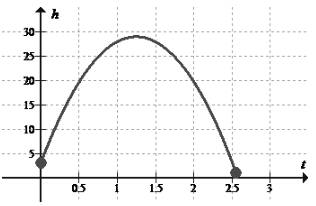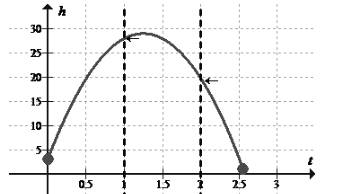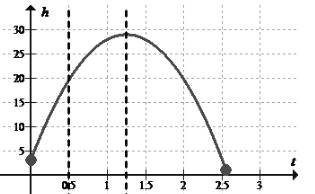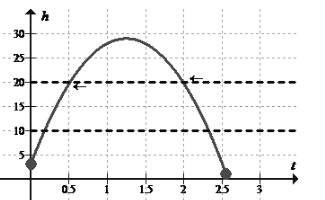
Concept explainers
(a)
h as the function of t.
(a)
Answer to Problem 96E
The vertical line cross the graph at one points, hence, the given relation define
Explanation of Solution
Given:
The function then it is not possible for a vertical line to cross a graph more than once else the graph is not the graph of a function
Calculation:
The graph represents the height

If a given graph is a function then it is not possible for a vertical line to cross a graph more than once else the graph is not the graph of a function.
To understand the crossing at two points means for a given input for getting two outputs or two
Now, draw random parallel line to check whether it is function or not.

Clearly here the vertical line cross the graph at one points, hence, the given relation define
Conclusion:
The vertical line cross the graph at one points, hence, the given relation define
(b)
The height of the projectile after 0.5 second and after 1.25 seconds.
(b)
Answer to Problem 96E
The height of projectile after 0.5 second and after 1.25 second is between 20 and 29.
Explanation of Solution
Given:
The function then it is not possible for a vertical line to cross a graph more than once else the graph is not the graph of a function
Calculation:
To find the height of projectile after 0.5 second and after 1.25 seconds, draw line parallel to haxis at

From the above graph it is very clear that the height of projectile after 0.5 second and after 1.25 second is between 20 and 29. At t = 1.25 the height is at maximum point; after that it starts decreasing.
Conclusion:
The height of projectile after 0.5 second and after 1.25 second is between 20 and 29.
(c)
The domain of h.
(c)
Answer to Problem 96E
The domain is
Explanation of Solution
Given:
The function then it is not possible for a vertical line to cross a graph more than once else the graph is not the graph of a function
Calculation:
The domain is the set of all
Therefore the domain is
Conclusion:
The domain is
(d)
t as function of h.
(d)
Answer to Problem 96E
The given relation doesn’t define
Explanation of Solution
Given:
The function then it is not possible for a vertical line to cross a graph more than once else the graph is not the graph of a function
Calculation:
Draw random line parallel t- axis

Clearly here the horizontal line cross the graph at two points, hence, the given relation doesn’t define
Conclusion:
The given relation doesn’t define
Chapter 1 Solutions
EBK PRECALCULUS W/LIMITS
- A 20 foot ladder rests on level ground; its head (top) is against a vertical wall. The bottom of the ladder begins by being 12 feet from the wall but begins moving away at the rate of 0.1 feet per second. At what rate is the top of the ladder slipping down the wall? You may use a calculator.arrow_forwardExplain the focus and reasons for establishment of 12.4.1(root test) and 12.4.2(ratio test)arrow_forwarduse Integration by Parts to derive 12.6.1arrow_forward
- Explain the relationship between 12.3.6, (case A of 12.3.6) and 12.3.7arrow_forwardExplain the key points and reasons for the establishment of 12.3.2(integral Test)arrow_forwardUse 12.4.2 to determine whether the infinite series on the right side of equation 12.6.5, 12.6.6 and 12.6.7 converges for every real number x.arrow_forward
- use Corollary 12.6.2 and 12.6.3 to derive 12.6.4,12.6.5, 12.6.6 and 12.6.7arrow_forwardExplain the focus and reasons for establishment of 12.5.1(lim(n->infinite) and sigma of k=0 to n)arrow_forwardExplain the focus and reasons for establishment of 12.5.3 about alternating series. and explain the reason why (sigma k=1 to infinite)(-1)k+1/k = 1/1 - 1/2 + 1/3 - 1/4 + .... converges.arrow_forward
 Calculus: Early TranscendentalsCalculusISBN:9781285741550Author:James StewartPublisher:Cengage Learning
Calculus: Early TranscendentalsCalculusISBN:9781285741550Author:James StewartPublisher:Cengage Learning Thomas' Calculus (14th Edition)CalculusISBN:9780134438986Author:Joel R. Hass, Christopher E. Heil, Maurice D. WeirPublisher:PEARSON
Thomas' Calculus (14th Edition)CalculusISBN:9780134438986Author:Joel R. Hass, Christopher E. Heil, Maurice D. WeirPublisher:PEARSON Calculus: Early Transcendentals (3rd Edition)CalculusISBN:9780134763644Author:William L. Briggs, Lyle Cochran, Bernard Gillett, Eric SchulzPublisher:PEARSON
Calculus: Early Transcendentals (3rd Edition)CalculusISBN:9780134763644Author:William L. Briggs, Lyle Cochran, Bernard Gillett, Eric SchulzPublisher:PEARSON Calculus: Early TranscendentalsCalculusISBN:9781319050740Author:Jon Rogawski, Colin Adams, Robert FranzosaPublisher:W. H. Freeman
Calculus: Early TranscendentalsCalculusISBN:9781319050740Author:Jon Rogawski, Colin Adams, Robert FranzosaPublisher:W. H. Freeman
 Calculus: Early Transcendental FunctionsCalculusISBN:9781337552516Author:Ron Larson, Bruce H. EdwardsPublisher:Cengage Learning
Calculus: Early Transcendental FunctionsCalculusISBN:9781337552516Author:Ron Larson, Bruce H. EdwardsPublisher:Cengage Learning





